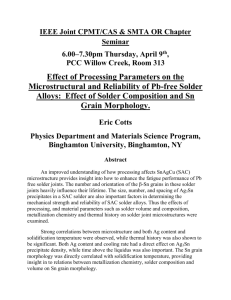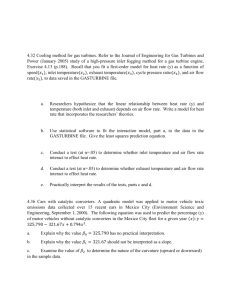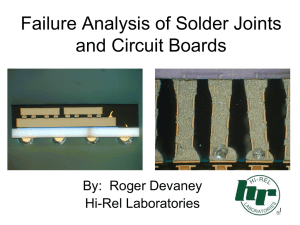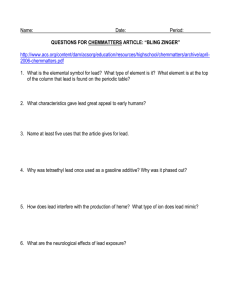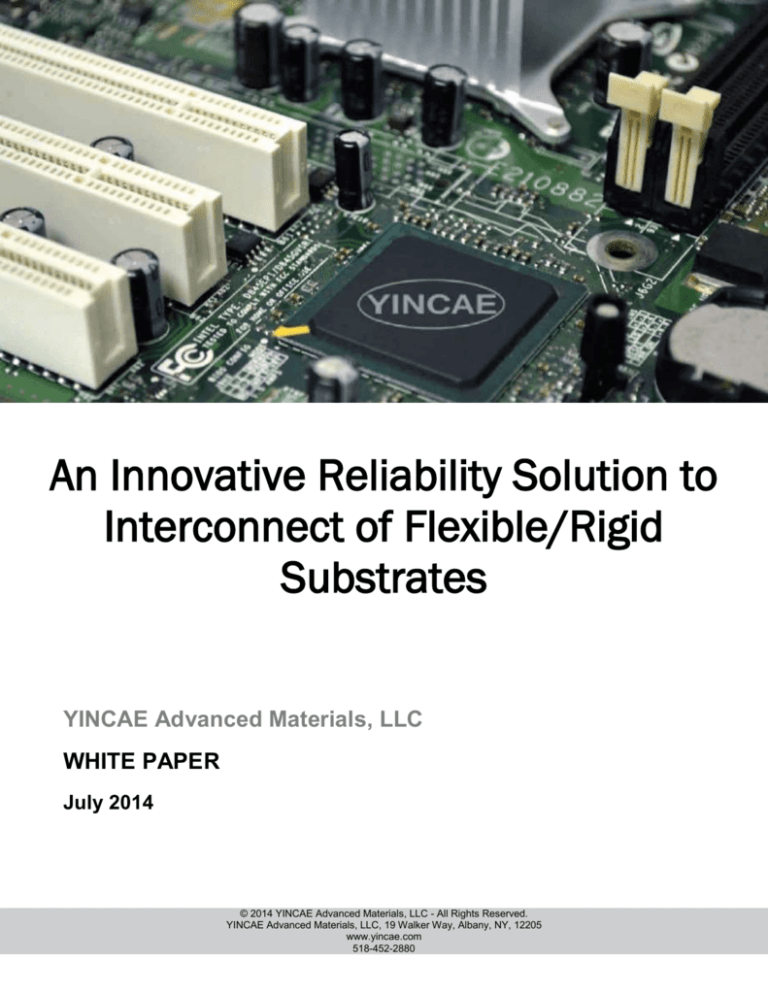
An Innovative Reliability Solution to
Interconnect of Flexible/Rigid
Substrates
YINCAE Advanced Materials, LLC
WHITE PAPER
July 2014
© 2014 YINCAE Advanced Materials, LLC - All Rights Reserved.
YINCAE Advanced Materials, LLC, 19 Walker Way, Albany, NY, 12205
www.yincae.com
518-452-2880
An Innovative Reliability Solution to Interconnect of
Flexible/Rigid Substrates
Dr. Mary Liu and Dr. Wusheng Yin
YINCAE Advanced Materials, LLC, Albany, NY
ABSTRACT:
With the pitch size of interconnect getting finer and finer, the bonding strength between
flexible and rigid (e.g. PCB, ceramic) substrates becomes a serious issue because it is not strong
enough to meet the customer’s requirement. Capillary underfill has been used to enhance the
bonding strength between flexible and rigid substrates, but the enhancement is very limited,
particularly for high temperature application. The bonding strength of underfilled flexible/rigid
interconnect is dramatically decreased after being used at 180◦C, and the interconnects are
weakened by the internal stress caused by the expansion of underfill at high temperatures. In
order to resolve reliability issues of the interconnect between flexible/rigid substrates, solder
joint encapsulant was implemented into the thermal compression bonding process, which was
used to manufacture the interconnect between flexible/rigid substrates. Compared to the
traditional process, the strength of the interconnect was doubled and the reliability was
significantly improved in high temperature application.
INTRODUCTION:
Miniaturization is a trend in the
electronic
industry,
which
has
increasingly attracted more attention.
However, the manufacturing process and
reliability have become more and more
challenging due to miniaturization. The
solder joint starts to lose mechanical
strength, which not only causes issues
for the drop performance, but also issues
for thermal cycling performance. In
order to enhance mechanical strength of
BGA/CSP, POP, etc., board-level
underfill has been used to fill in between
solder joints, but thermal cycling
performance is sacrificed. A big hurdle
is the rework issue of underfill.
Reworkability is particularly important
during high volume production. Solder
joint encapsulant only enhances solder
joint strength and won’t cause internal
stress for solder joints because there is
no adhesive between solder joints. The
reworkability of solder joint encapsulant
adhesive is same as solder paste. Thus,
solder joint encapsulant successfully
provides a low cost and high reliability
solution for high volume or high
reliability production.
Miniaturization not only occurs in
microchips, but also in interconnects
between
flexible/rigid
substrates.
Interconnects between flexible/rigid
substrates face the same issues of poor
mechanical strength and thermal cycling
performance as microchips. In order to
resolve the reliability issues for
interconnects between flexible/rigid
substrates due to miniaturization, solder
joint encapsulant was implemented into
the thermal compression bonding
process to manufacture the interconnect
between flexible/rigid substrates. The
implementation
of
solder
joint
encapsulant doubled the bonding
strength between flexible and rigid
substrates, and dramatically enhanced its
reliability,
particularly
at
high
temperature application.
PROCESS:
Print solder paste
onto flexible
substrates
Semi-reflow
solder paste
solder joint encapsulant adhesives can
provide advantages of simple, short and
high throughput manufacturing process
over traditional solder paste plus
underffilling process. SMT 266 is
directly applied onto semi-reflowed
solder paste by brushing, soldering and
curing of adhesive is combined in one
step. The reflow process of solder joint
encapsulant adhesive is fully compatible
with the typical industry high
temperature solder paste thermal
compression bonding process. During
solder bonding process, solder joint
encapsulant adhesive SMT 266 can
remove metal oxide from pads and
bumps to allow solder joint to be
formed, then cure with the formation of
a 3-D polymer network encapsulating
each individual solder joint. Between
solder joints, there is no adhesive
blocking outgassing channels to ensure
high process yield. The Schematic SMT
266 encapsulated solder joint is shown in
Figure 2 below.
Solder
Joint
Solder Joint
Encapsulant
Apply SMT 266
Thermal
Compression
Bonding
Fig. 1 Process Flow Chart
The application process of solder
joint encapsulant adhesive is shown in
Figure 1 above. It should be noted that
Fig. 2 Schematic cured SMT 266
encapsulated solder joint
UNDERFILLING
INTERCONNECTS
OF
FLEXIBLE/RIGID SUBSTRATES
The
Schematic
bonding
of
flexible/rigid substrate is shown in
Figure 3 below. High temperature solder
paste was used in the thermal
compression bonding process. After
thermal compression bonding, five
different underfills were used to
underfill
these
interconnects
of
flexible/rigid substrates.
Fig. 5 Pull strength using different
underfills
Fig. 3 Schematic of Flexible/Rigid
bonding
The photos of the substrates after the
pull test are shown in Figure 6 below.
From Figure 6, it can be seen that the
pads were peeled off from flexible
substrates, which means that before high
temperature treatment, the adhesion and
soldering strength were very good.
After underfilling and curing of these
interconnects of flexible/rigid substrates,
the pull test was conducted and the test
is shown in Figure 4 below.
The results of pull strength versus
different underfills were plotted and
shown in Figure 5. From Figure 5, we
can easily see A and E underfills have
demonstrated good adhesion in between
flexible and rigid substrates. These
underfilled interconnects were subject to
a high temperature storage test later.
(a) Ceramic substrate
Fig. 4 Pull Test Schematic
40
Pull Strength (N)
35
30
25
20
15
10
5
A
B
C
D
E
(b) Flexible substrate
Fig. 8 Photo of flexible substrate after
high temperature treatment and pull test
After the underfilled interconnects
rigid/flexible substrates were stored at
185C for 40 hours, the results of the
pull test are shown in Figure 7 below.
From Figure 7, it should be noted that
the pull strength was significantly
decreased compared to that before high
temperature treatment and all of them
failed because the pull strength was less
than 10N. There are two factors
contributed to the dramatic decrease in
pull strength after high temperature
treatment. One is that the flux residue
becomes soft or semi-liquid, which
weakens the adhesion from underfill.
Another contributing factor is that high
CTE of underfill at high temperature
causes large internal stress for solder
interconnects, which weakens the
strength of the interconnects of
rigid/flexible substrates.
After high temperature treatment, a
pull test was conducted on the
underfilled interconnects. The photo of
the flexible substrate is shown in Figure
8. It is very interesting to note that the
failure occurred in
the solder
interconnects and there was no underfill
left on the flexible substrate after high
temperature treatment. This is in
agreement with the dramatic decrease in
pull strength after the high temperature
test.
10
8
6
4
2
0
A
B
C
D
SOLDER JOINT ENCAPSULANT
ADHESIVE
USED
IN
INTERCONNECTS
Solder joint encapsulate adhesives
was used to replace traditional flux
during thermal compression bonding
process to form interconnects between
rigid and flexible substrates. The results
of pull test are shown in Figure 9 below.
It should be noted that using solder joint
encapsulant adhesive (SMT 266) passed
the pull test 100% of the time, while
using traditional flux passed only 67% of
the time, even before high temperature
treatment (185C for 40 hours).
E
Fig. 7 Pull strength using different
underfills after high temperature
treatment
Pull Strength (N)
Pull Strength (N)
Fig. 6 Photos of (a) ceramic and (b)
flexible substrates after pull off
22
12
2
A
B
Fig. 9 Pull strength of interconnects
using A- traditional flux and B- SMT
266
Like the underfilled interconnects,
these interconnects, which were made
using flux and solder joint encapsulant
adhesive,
also
underwent
high
temperature treatment (185C for 40
hours), followed by the pull test. The
results of pull test are shown in Figure
10 below.
Pull Strength (N)
From Figure 10, we can see that the
strength of interconnects using flux
decreased dramatically and failed the
pull test almost 100% of the time after
high temperature treatment. Pull strength
of the interconnects also dropped while
using solder joint encapsulate adhesive
SMT 266, but passed the pull test 100%
of the time. It is also interesting to note
that the strength was still almost double
of the strength using traditional flux. It is
most important to note that using solder
joint encapsulant adhesive also leads to a
much smaller standard deviation than
that using traditional flux.
12
7
2
A
B
Fig. 10 Pull strength of the interconnect
using A- traditional flux and B- SMT
266 after high temperature treatment
CONCLUSION:
With increasing miniaturization in the
electronic industry, the strength of solder
joint or interconnects presents a
challenging issue. Underfilling the
interconnects of rigid/flexible substrates
does not solve the problem. Solder joint
encapsulant
adhesive
(SMT266)
provides a reliable solution to the
interconnect of rigid/flexible substrates.
Using solder joint encapsulant adhesive
not only doubles the strength of the
interconnect
compared
to
using
traditional flux, but also ensures 100%
manufacturing process yield. Solder
joint encapsulant adhesive is used in line
process,
thus
shortening
the
manufacturing process.
REFERENCES:
1. Mary Liu and Wusheng Yin, "Solder
Joint Encapsulate - Miniaturization
Solution", APEX , Las Vegas, Nevada,
March 25- 27th, 2014.
2. Mary Liu and Wusheng Yin, "A
Novel High Thermal Conductive
Underfill for Flip Chip Application"
and "Solder Joint Encapsulant Adhesive
- LGA High Reliability and Low Cost
Assembly Solutions." IMAPS Orlando,
Florida from October 1-3, 2013.
3. Mary Liu and Wusheng Yin, "Solder
Joint Encapsulate Adhesive - PoP TMV
High Reliability and Low Cost
Assembly Solution" , SMTA, Fort
Worth, Texas, October 15-17th, 2013.
4. Mary Liu and Wusheng Yin, "Solder
Joint Encapsulate Adhesive - PoP TMV
High Reliability and Low Cost
Assembly Solution", IMAPS, Albany,
NY, April 30th, 2013.
5. Mary Liu and Wusheng Yin, "Solder
Joint Encapsulant Adhesive - POP
Assembly Solution" , NEPCON,
Shenzhen, China, August 29, 2012
6. Mary Liu and Wusheng Yin, " A
First Room Temperature Stable and
Jettable Solder Joint Encapsulant
Adhesive" in IMAPS New England - 38
th Symposium & Expo, May 3, 2011
7. Mary Liu and Wusheng Yin had
technical poster" A First Individual
Solder Joint Encapsulant Adhesives" in
Raleigh NC, IMAPS, November 3, 2010
For additional information Contact:
YINCAE Advanced Materials, LLC
19 Walker Way
Albany, NY 12205
(518) 452-2880
http://www.yincae.com/
info@yincae.com
WP-0725-4/2014
8. Mary Liu and Wusheng Yin Presented
" World First Solder Joint Encapsulant
Adhesives" in Shenzhen (China),
NEPCON, August 31, 2010
9. Mary Liu and Wusheng Yin
presented " A First Individual Solder
Joint Encapsulant Adhesives" in San
Francisco, SEMICON West/IMAPS,
July 14, 2010



